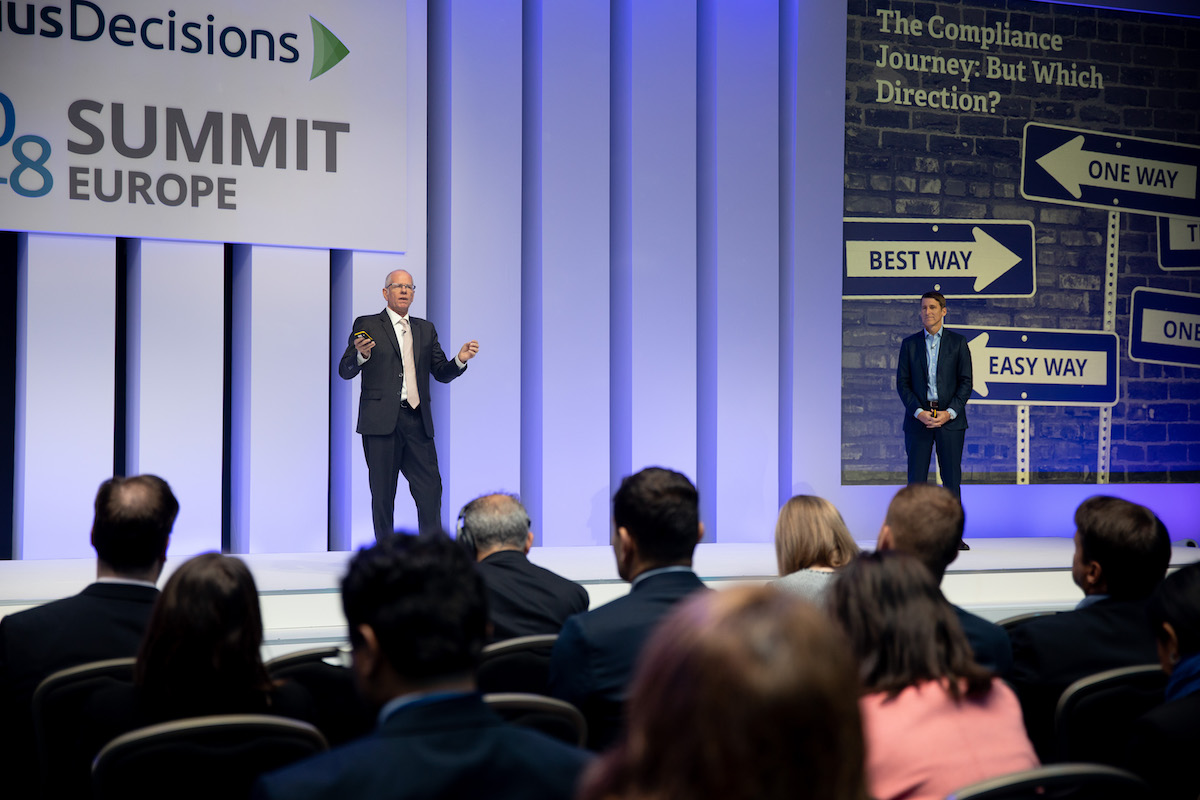Data Privacy and Compliance: Regulations Don’t Have to Be Scary
- Regulatory compliance is often thought of as a burden or a threat to an organization’s bottom line
- But it doesn’t have to be this way, as some rules – such as GDPR – can help enhance cross-functional alignment
- At Summit Europe 2018, Julian Archer and Phil Harrell described how B2B organizations can use data privacy compliance to their advantage
In the business world, rules and regulations are often thought of as burdensome, onerous and potentially costly. What does this mean for our bottom line? Will this add to the cost of doing business? What sort of legal counsel do we need to ensure we’re complying with the rules coming from the various agencies? Do we need to hire a consulting firm to do this for us? And what if something goes wrong and we must pay a penalty?
This was certainly true of sweeping financial legislation like Basel III, Dodd-Frank and Sarbanes-Oxley, but what about the new General Data Protection Regulation (GDPR) regulations set by the EU? There’s certainly a lot to think about from the standpoint of the C-suite, including chief sales officers (CSOs) and CMOs. But does GDPR have to be exclusively an item of concern? Or could it yield a potential opportunity for better alignment between sales and marketing? Besides, the whole purpose of GDPR was to serve the wider ethical principle that every person should be able to engage with the digital world with the confidence that his or her private information will be secure.
 This was the case Julian Archer and Phil Harrell made to the audience at Summit Europe today in London, through the lens of the SiriusDecisions Data Privacy Compliance Model. This model provides a structure that sales and marketing can use to operate aligned and compliant data processes. Privacy regulations force marketing and sales to work closely together and better define roles and responsibilities. For example, marketing determines the extent of personal data requirements, teleservices captures consent, direct sales conducts an opt-in discussion, and channel teams look to gain clarity on the purpose of personal data use.
This was the case Julian Archer and Phil Harrell made to the audience at Summit Europe today in London, through the lens of the SiriusDecisions Data Privacy Compliance Model. This model provides a structure that sales and marketing can use to operate aligned and compliant data processes. Privacy regulations force marketing and sales to work closely together and better define roles and responsibilities. For example, marketing determines the extent of personal data requirements, teleservices captures consent, direct sales conducts an opt-in discussion, and channel teams look to gain clarity on the purpose of personal data use.
Julian described the range of reactions he’s heard in relation to GDPR: “I’ve had people say to me, ‘Julian! What do I do? How do we follow these rules? How do I get away with it?’ But I’ve also had people say, ‘Wait, there’s an opportunity here.’ ”
In a similar vein, Phil stressed to the sales portion of the audience that “You need to be interested in this subject and so you can use GDPR to help drive alignment with marketing and because there are real benefits to sales. These include helping to clean up dirty data in internal systems, and instilling trust in prospects and employees. All of this shows that you care about protecting personal data.”
From here, Julian and Phil explored some examples of companies that are investing to ensure compliance and derive business improvements: 3M, New Relic, Siemens and FIS. These real-life examples helped to clarify the importance of sales and marketing in this effort. Companies need to minimize risk and create a safe environment in which sales reps and marketers can generate business. This requires visibility into and control over how data enters systems like sales force automation systems and marketing automation platforms. Organizations can also use these and other systems to monitor, audit and protect data privacy compliance. This saves time and opens capacity for sales reps and marketers get back to their day jobs. Additionally, it creates a stimulus to clean up data, as Julian emphasized during the New Relic example: “It’s not because GDPR said to clean up the data, but because it was a catalyst for marketers to look at the data anyway.”
In the example of FIS – which won a SiriusDecisions 2017 Program of the Year award – the organization used a comprehensive governance and compliance initiative to obtain fantastic results: email open rates of 25 percent or more (sometimes as high as 94 percent!), 47 percent better engagement, and a database where more than 60 percent of the data remained available for marketing’s use. And this was all after cleaning data, creating preference centers and gaining opt-in permissions. This clearly shows that, far from hindering marketing’s ability to operate, getting into compliance can enhance execution and engagement.
In closing, Julian gave special shout-out to marketing leaders and marketing operations: “As marketing leaders, we need to put privacy laws to work to our advantage. Also, this is a great opportunity for marketing operations. You can really be the heroes here.”
As Phil and Julian demonstrated to the audience, using privacy laws to guide customer engagement, sales and marketing can ensure that the organization remains in compliance and becomes widely trusted among B2B customers. This requires a holistic approach via personal data lifecycle management and sales enablement that works across people, process and technology.